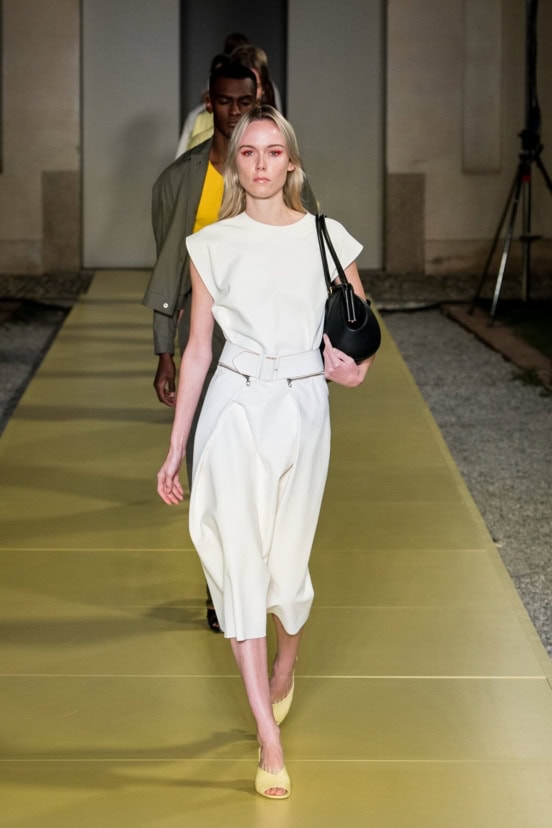Reviews of Giorgio Armani, Moschino, Salvatore Ferragamo, Emilio Pucci/Tomio Koizumi, & Ports 1961 Spring 2021 Fashion Shows
Timelessness & The Now
By Long Nguyen
GIORGIO ARMANI
Digital/Filmed Live Show
“I created all my work around the jacket. It was my point of departure for all my work from the end of the 1970s until today. I have updated the jacket without betraying its spirit, saying he had to defy convention without losing the past,” Giorgio Armani said in a 1990 documentary film ‘Made in Milan’ by the director Martin Scorsese. The camera focused in as Armani sat around a table with black and white sketches in front of him ad also a set of design assistants as he drew with his pencil while explaining a part of the shoulder or the lines around the waist.
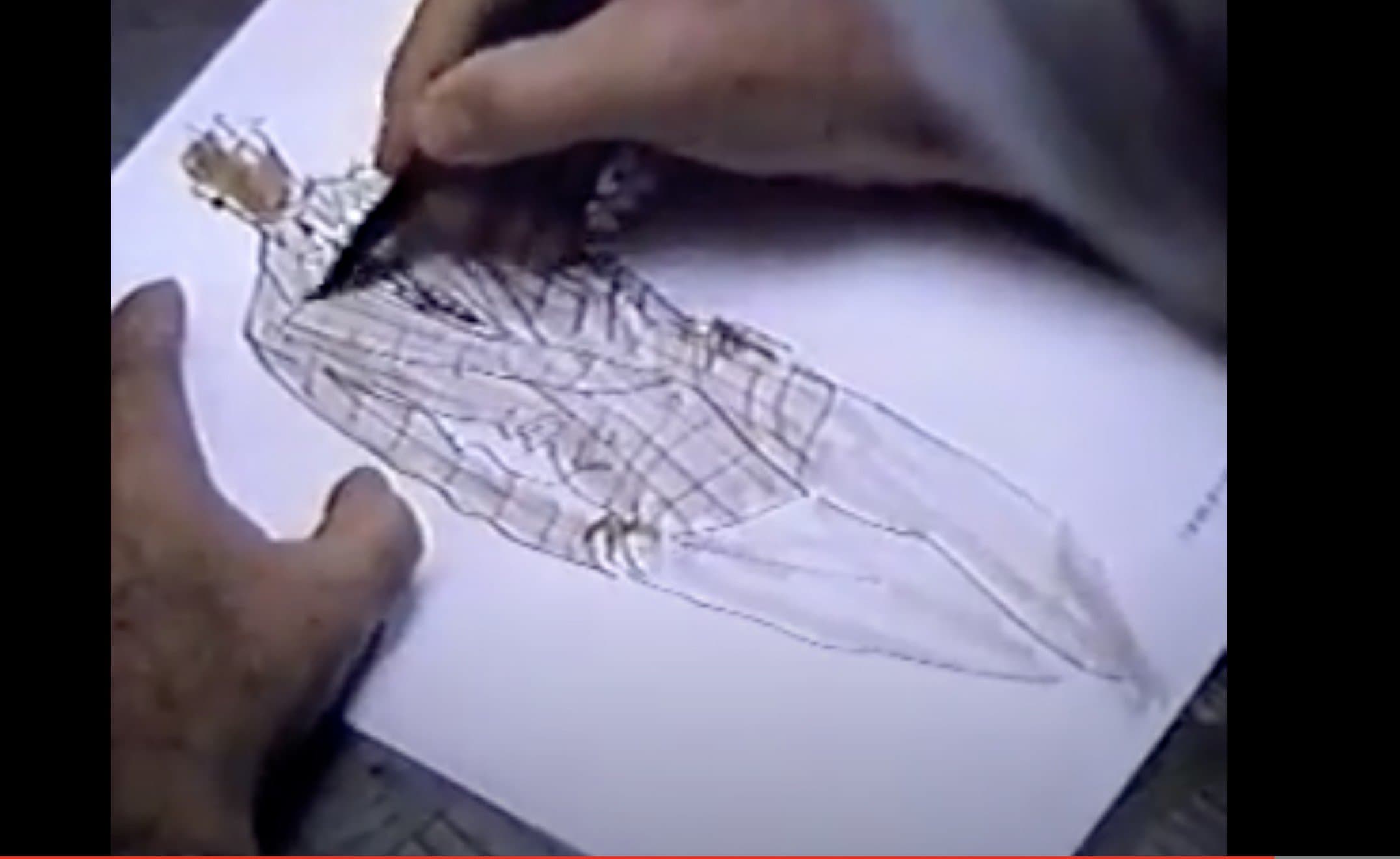
In the next scene, Armani used his hands and a scissor first to cut out the inside lining of a jacket then he yanked out the shoulder pads and any other reinforcements placed within the inside structure to maintain the shape of the jacket. He then threw what remained as the outer shell of the original jacket on the table. What might have been perceived as defects could then became the start of a new shape and a new jacket that acted exactly like a second skin. “I discovered that a jacket can be very sensual,” he said.
All of these Armani jackets that so many customers throughout the world have owned and owned in so many of their manifestations and tweaks over these decades remained at their core the same jacket that the designer mentioned thirty years ago in this documentary.
“Anything that’s rigidly defined, that’s perfect and unchangeable irritates me. It gives me the feeling of something too well planned,” he said as he showed how he intentionally left section of his home in Milano partially unfinished perhaps in the exact way that he had left some of the jackets unfinished until the next time he could revisit them and perhaps then add or subtract small elements.
To understand the fashion work of Giorgio Armani is to let go of the many inherited notions of fashion that are familiar in the general discourses on all the changes the industry had experienced in the last few decades.
Armani fashion designs over these four and a half decades have so ingrained the visual spectrum of fashion – his garments and signature silhouettes and style have become so familiar that at the time it has become hard to distinguish. It’s so there now that we can no longer see it just like we can never see the air we breathed. “The first rule is to be faithful to your self,” he said exactly thirty years ago. Perhaps he should have said that the only rule should be always faithful to your own beliefs and visions.
“I have always insisted upon rigorous simplicity. I can’t stand exhibitionism,” Armani said in the film when he mentioned the simple elegance he saw in his parents. Society may have changed and his clothes have also changed albeit at a snail pace when a new design element called for altering any garments.
I prefer quiet elegance, an understated style. My effort as a designer is just that. I always try to design looks that complement the personality of who chooses to wear them, in which they can feel at east, not as a disguise.
Giorgio Armani, via Instagram just 2 days before his Spring 21 showing
But understanding begins with knowing where and perhaps how to look. Armani provided a clue saying that when he first moved to Milano the city was a bit dark, its streets and buildings imposing and he felt aloof. But as the new designer soon discovered, like anyone else who visited the city, it was necessary in Milano to pass through the front gate and enter to find spacious courtyards and gardens once inside. “It is a city that allows you to express yourself and respect you if you have something to say.”
In a film of his spring show staged at Teatro at the company headquarter and broadcast on Italian LA7 television, Armani showed the command of his fashion codes so firmly that even when the men and women models walked in their fluid light grey suiting with the fabrics swinging lightly along with their bodies, you recognize the clothes and you recognize the brand. There and in the now the single breast jacket in light grey linen with two buttons isn’t so much unlike the one Armani tore apart long ago to demonstrate to his design team the softness of the unlined jacket, a design unheard of at the time of its conception. That charcoal washed linen double breast vest with buttoning on the side of the body showing a v-neckline is also a signature garment seen over and over – for winter-worn over shirts or knits and for summer like in the show worn just over bare skin. But look carefully and there’s a new shape in the black lapel less jacket that together with a matching vest formed a triangle opening at the neck and paired with pants cut shorter about halfway down the knee.
For women, the mandarin collar jacket with a strong shoulder or the single breast crop jacket often worn with slim or loose pants is the anchors along with those flowing coats. The same men’s jackets are seen here on the women with little alterations. Even the evenings are kept simple with much less embellishment – “In my evening gowns, I always try to make sense of simplicity prevail. They’re sophisticated yet pleasant to wear, elegant and beaming, for the colors and fabrics. They are never costumes.” That can be said of the light green double organza long sleeveless dress with neck folds or lightly sparkle black long dress. “I want to make my woman evolve, not betray her,” he said from an RAI TV interview from 1987.
The spring collection’s shapes are mostly slightly loose with garments cut with just a little more room to allow some movements but not too much. The fabrics, linens or tropical wools, are chosen for their versatility, for their lightweight and in neutral and soft pastel colors.
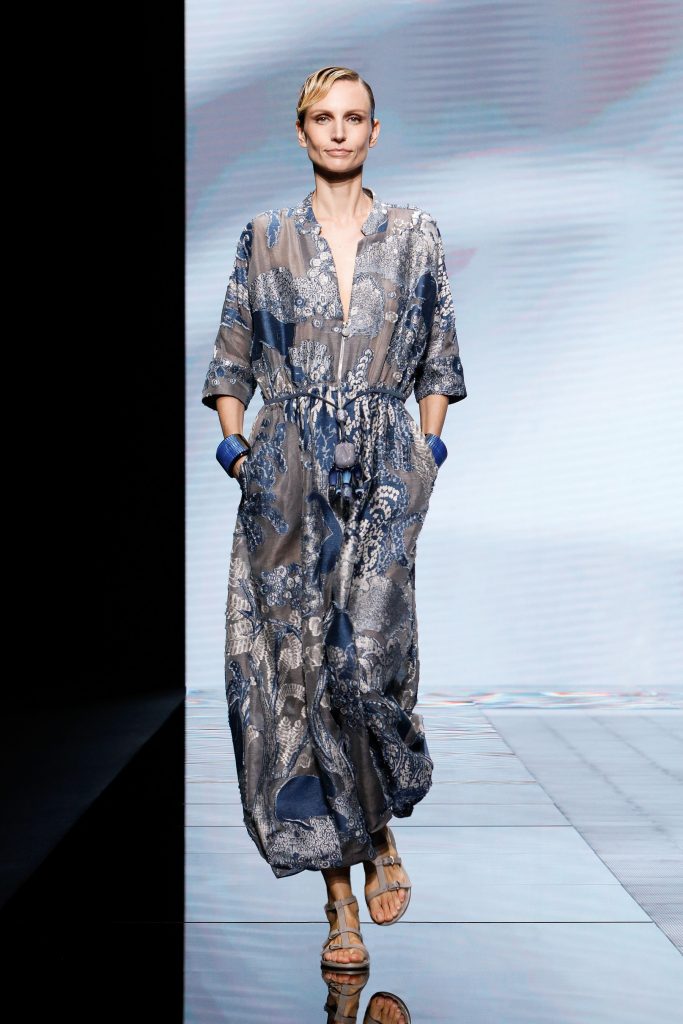
The new and updated documentary that aired on Italian television after the show entitled ‘Timeless Thoughts’ filmed thirty years after the release of ‘Made in Milan’ is remarkably similar, in fact, they are complimentary of each other. With high tech cameras, the new film showed Armani and his atelier at work at fittings of new clothes on models.
“Fashion is a reflection of our time, it has the ability to anticipate the future, the changing and the evolution of our society,” the Italian actor Pierfrancisco Favino narrated the short film that combined a collage of old footages with current ones
Over the years Armani has build his community and his audience with this language of consistency, of offering a style of clothes that have always served those who wore them.
You have to serve the people, you have to please them because they are the ones you have to share your emotions with.
– Giorgio Armani, on his Instagram teaser
The clothes he made for Richard Gere in the movie American Gigolo remained a unique moment when fashion and cinema converged in a way so natural that it was hard to see the film and thought ah it’s a fashion movie. The cadre of his long time Hollywood fans is another community he has established long before VIP dressing became a thing today.
“You can invent the most beautiful garments, but if you create garments that don’t belong to the world you live in and to the society that lives in it, it makes no sense,” the designer said in a 2015 interview in the new documentary. In yesterday’s review, I talked about the needs for designers to be fully engaged in creating a community people of shared ideas and shared values. But the how and the format to weave this community together are different for different designers.
At Armani, despite all the tech advances, it is still very much a person-to-person relationship as it has always been because that still remained a sold way to create community.
I think that the challenge has always been to adapt to the times without changing one’s nature, respecting one’s history and conviction, but at the same time focusing on the future through research.
_ Giorgio Armani
Past and present merge here like a jacket coming out at the shows seasons after seasons.
MOSCHINO
Digital
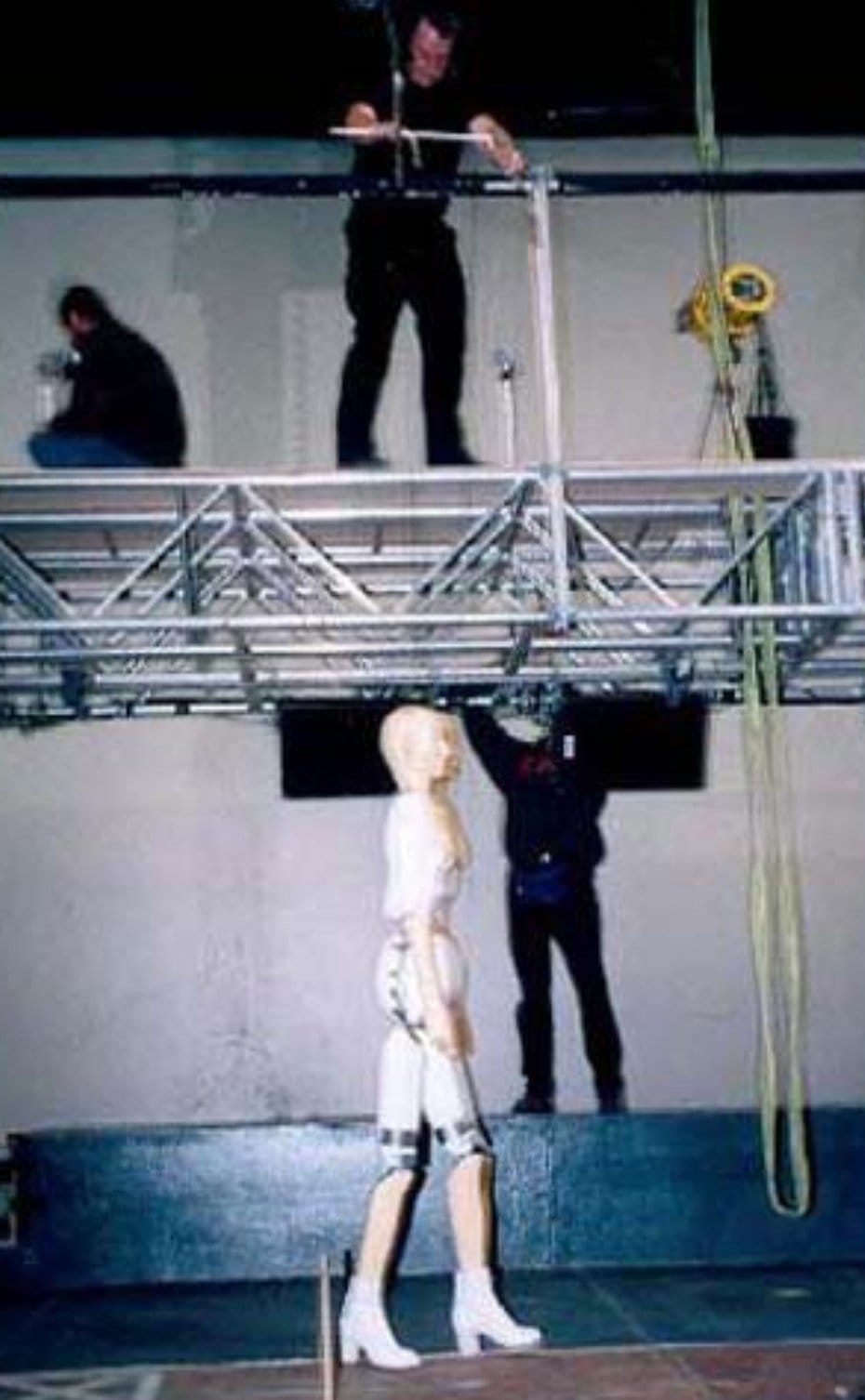
The first sight of Jeremy Scott’s short film of a puppet fashion show for his Moschino collection brought back many fashion memories from the distant past.
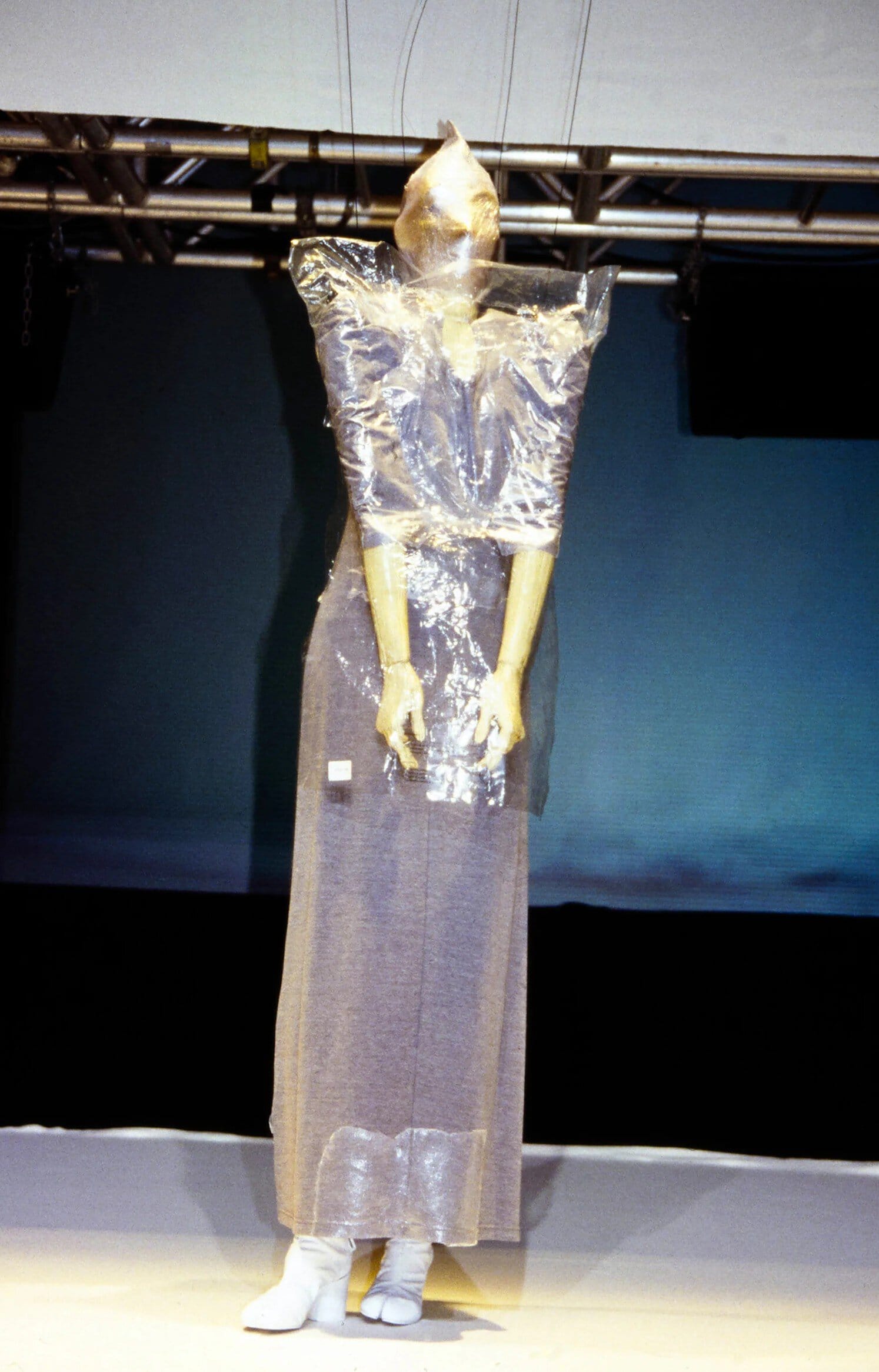
I remembered so clearly even now on that late evening in March 1998 going to La Défense, the business complex at the end of the Étoile, for a Martin Margiela show at 10 PM at night. The actual show did not start until just about 11 PM but in those days in Paris there were always late evening shows especially from young designers whose talents were electrifying the fashion scene with their unprecedented creative energy.
Then inside the grand foyer of the Grande Arche, the light dimmed and brightened again to reveal three or four men from above dangled several puppets across a stage with clothes some wrapped in saran wrap transparent materials. The men sent the puppets back and forth across the stage mimicking a live fashion show. It was not only Margiela’s stand against the rising system of supermodels that dominated fashion at that time but the Belgian designer introduced a high pagoda shoulder on jackets and dresses by way of a transparent Saran wrap around the shoulder of the puppets – a critical fashion design innovation that would begin a period of a renewed emphasis on constructions for Margiela.
In Jeremy Scott’s happy daylight version of a puppet fashion show staged with the familiar faces in the faux front row expected at these kinds of shows, the American Los Angeles based designer actually created miniature versions of what should be his full-scale clothes with the interplay of deconstruction and reconstruction. Created by Jim Henson’s Creature Shop, these puppets wore the clothes that showed how the inside became the outside and the outside became the inside like a sheer corset dress with gold brocade attached skirt, a blue brocade coat with protruding seams, or a pink tulle and jacquard short dress.

Inside out isn’t exactly a new concept in the history of fashion’s deconstruction movement. Here Scott executed his version of deconstruction in such an academic and serious way that an injection of his upbeat humor would surely have enlivened the film and more specifically given these Moschino clothes, in miniature or in real life sizes, a touch of the designer Jeremy Scott we all know.
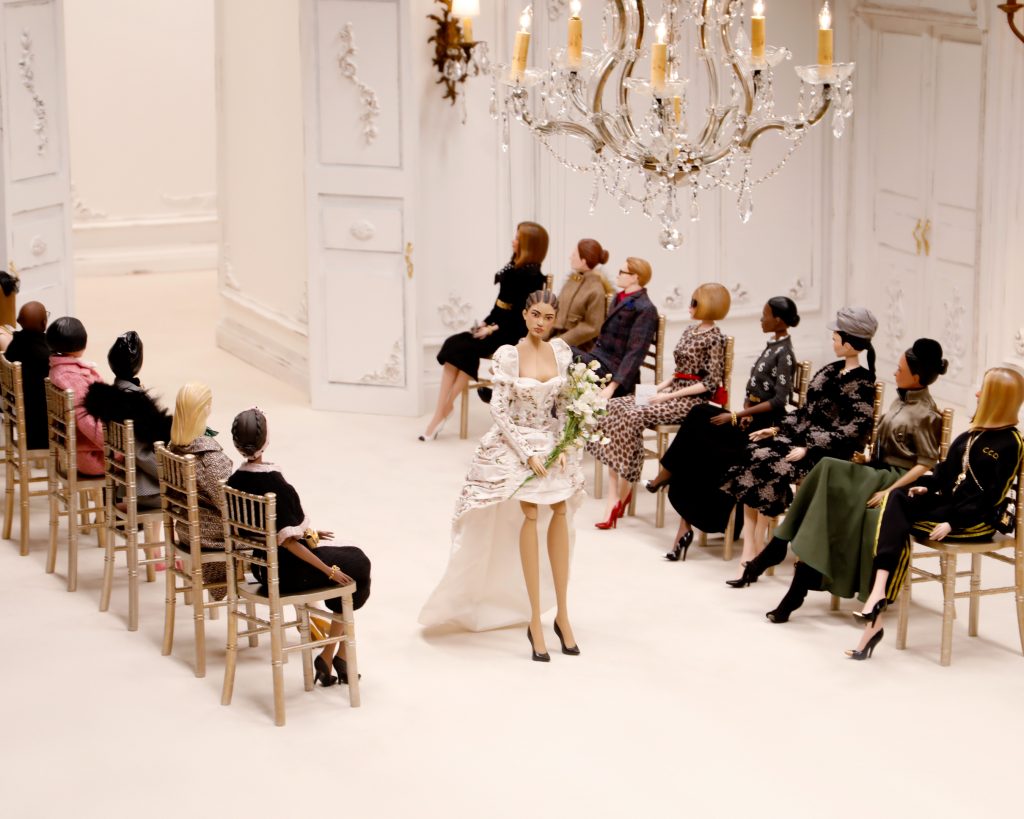
SALVATORE FERRAGAMO
Sfilate/Digital
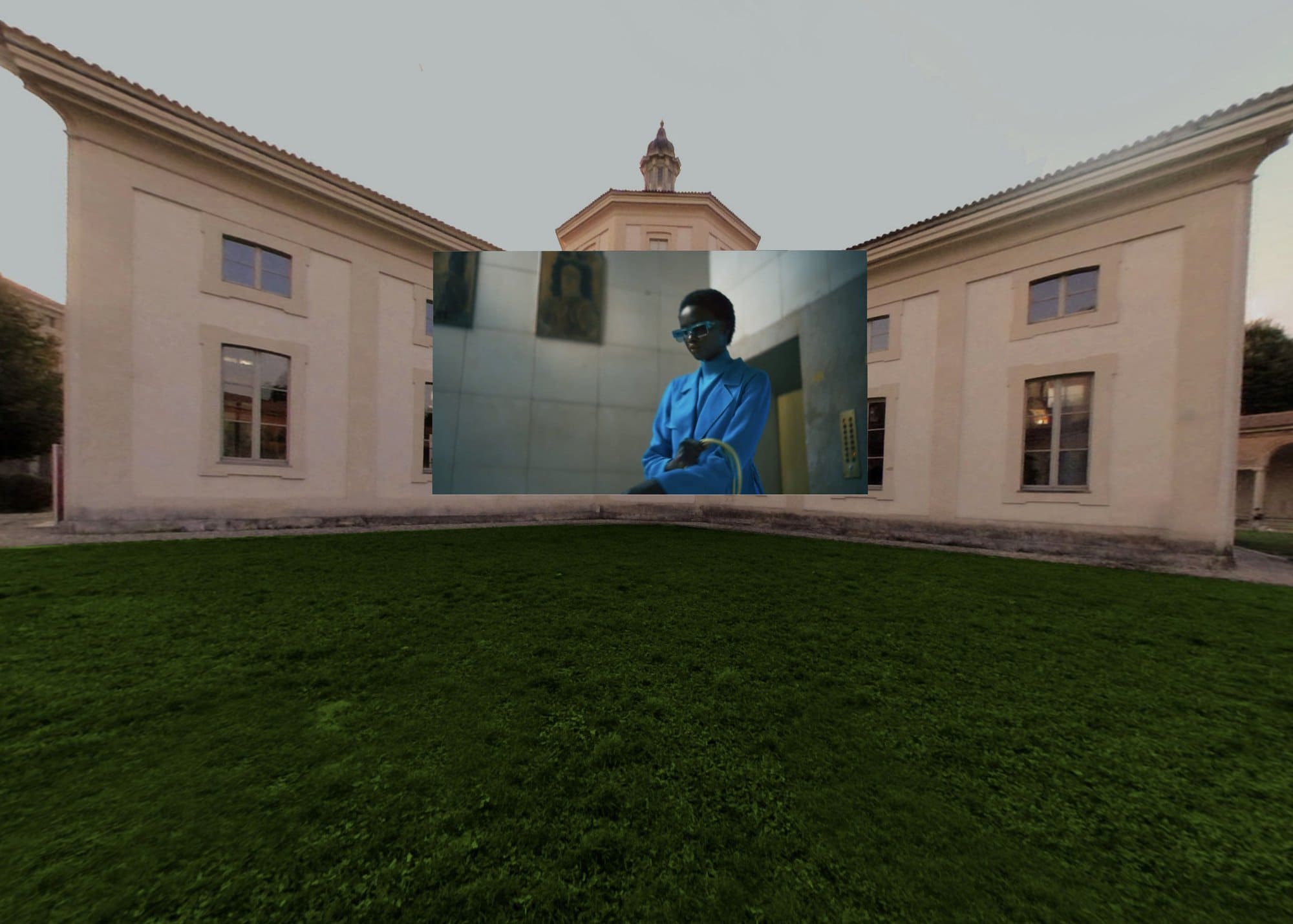
Paul Andrew, the creative director at Salvatore Ferragamo, gave his audience a double your pleasure moment by presenting his spring collection with showing a short film by Luca Guadagnino who filmed the models Mariacarla Boscono, Maggie Cheung, Jonas Glöer, Samer Rahma and Anok Yai walking through the empty streets and parks of Milano in August in a kind of mysterious chase of the unknown. Cheung wore a yellow/green plaid spread collar shirt/jacket with fitted pants while Boscono wore a long brown coat with decorations and yellow pants in one scene or a lapel less green skirt suit and an orange leather bag in another scene. They guys had on olive suits, a bright yellow coat and light blue leather blouson with brown pants and green shirt.

It was not clear what the plot was while the music roused a sense of suspense but the square toe leather sling backs were surely the best supporting cast among the bright colors clothes up and down the hills and staircases of the Milanese grounds in what the designer said he was inspired by Alfred Hitchcock movies during the hard lockdown like The Birds and Vertigo. Sounds of birds can be heard on the soundtrack prior to the start of the live show giving that audience a mood enhancer.
The live fashion show repeated some of the outfits from the film now on models walking on a light yellow carpet walkway in the duel between the real and the digital. Kiki Willems opened the show in a white leather dress with folding, Mariacarla Boscono wore the brown tank and pink pants, and Joan Smalls came out in a grey leather blouson, orange tee, and long belted skirt. The plaid shirt/jacket and pants, the brown coat with inlaid print and yellow pants, the grey blouson and long skirt, and the green skirt suits were a few of the women looks making a reappearance in real life. The yellow coat and grey pants, the grey leather blouson and black pants, and the green slim suit reemerged on the guys walking in the live presentation.
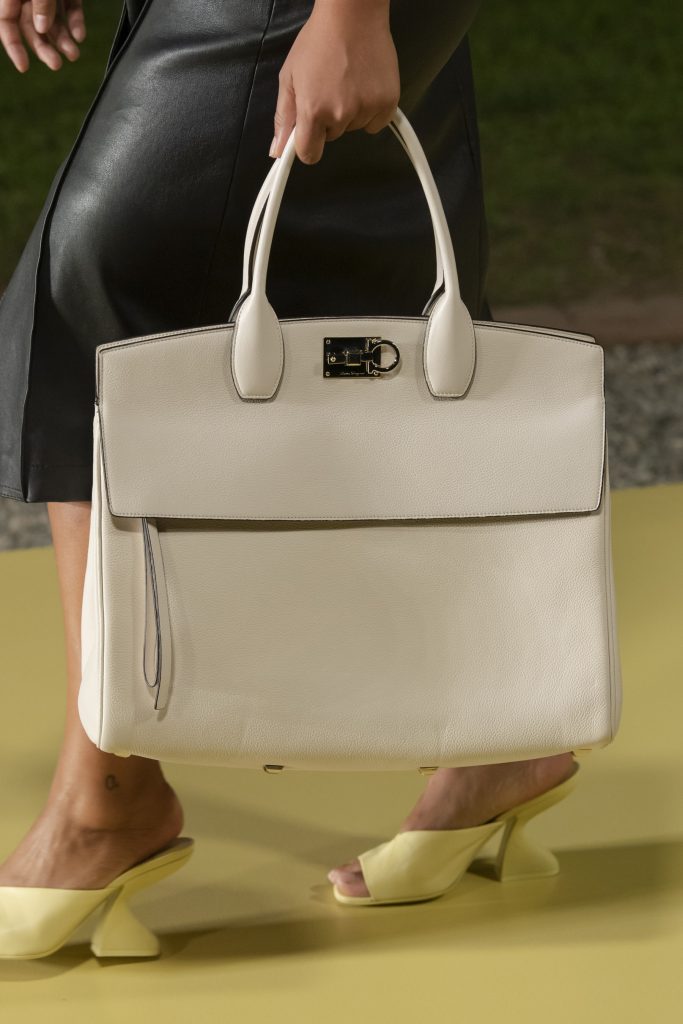
This isn’t a collection that is exciting enough to actually seen twice at least for the very limited audience present on the grounds in Milano even with its tight edit for the live show. No doubts the clothes are well made and with the best leathers and fabrics but they don’t say much at all in the film or on the models.
Deep pockets brands like Ferragamo always insist on competing in live fashion shows without any real reasons to do so. Certainly, these kinds of commercial clothes are not exactly runway ready. The short film is sufficient even much better here in conveying the thought and the clothes looked a bit brighter and more alive on film. That should have been a convincing argument against the live portion.
EMILIO PUCCI/TOMIO KOIZUMI
Digital
This is how the creative and business formula for fashion houses especially those founded in the last century that have managed to continue either without their founders or sold to corporate conglomerate.

This season the Emilio Pucci brand hired the Japanese designer Tomo Koizumi to refresh the house. Koizumi, whose meteoric rise with his poetic and artfully constructed colorful tulle sculpture dresses, can of notoriety after he showed in the basement floor of the Marc Jacobs store on Madison Avenue in February 2019. In a span of fewer than ten minutes, a new star in fashion was born, catapulted immediately to the top. His follow-up in September 2019 was equally dramatic, veered more towards fostering a visual enchantment with one model – Ariel Nicholson – enacting a series of on-screen changes of seven outfits in front of a small crowd around the staircase looking down. They showed masterful handiwork layering the silk caddy, silk twill, silk jersey, and silk organza into complex three-dimensional ‘art’ objects.
Koizumi brought his known and elaborate constructions with him to Pucci. However, his eleven ‘garments’ for Pucci were certainly a bit less extravagance that the previous New York outings for his own collection but nevertheless demonstrated his clever incorporations of the heritage of the Marquess Emilio Pucci especially in the novel ways he deployed the Pucci’s prints.
In a short video shot on the shoreline of Capri titled ‘Sulla Riva,’ models played in the rain and then canoed to an empty mansion and boom they discovered these fabulous structured gowns mounted on white pedestals like the colorful floral shape strapless bodysuit-dress or similar fabric as a strapless cocktail dress, a giant white silk ball sleeve long gown, or a double circular orange and yellow silk strapless dress. These were familiar Koizumi silhouettes from that first outing in what seemed an eternity ago on that cold Friday night on Madison Avenue in midtown Manhattan.
As a presentation of the spring collection or more likely just the mood of the collection, the ‘Sulla Riva’ video clearly showed the rift between the Pucci commercial collection and those Koizumi created with a striking juxtaposition of the scenes within the garden. On one hand, a bunch of models wearing the light and summer Pucci clothes like pink bra top and matching long skirt, light blue floral print jacket or light yellow sundress danced and laughed together and seemingly enjoying what could be a late summer afternoon in the sumptuous garden; on the other the stoic and sculptural dress on mannequin segregated inside the mansion.
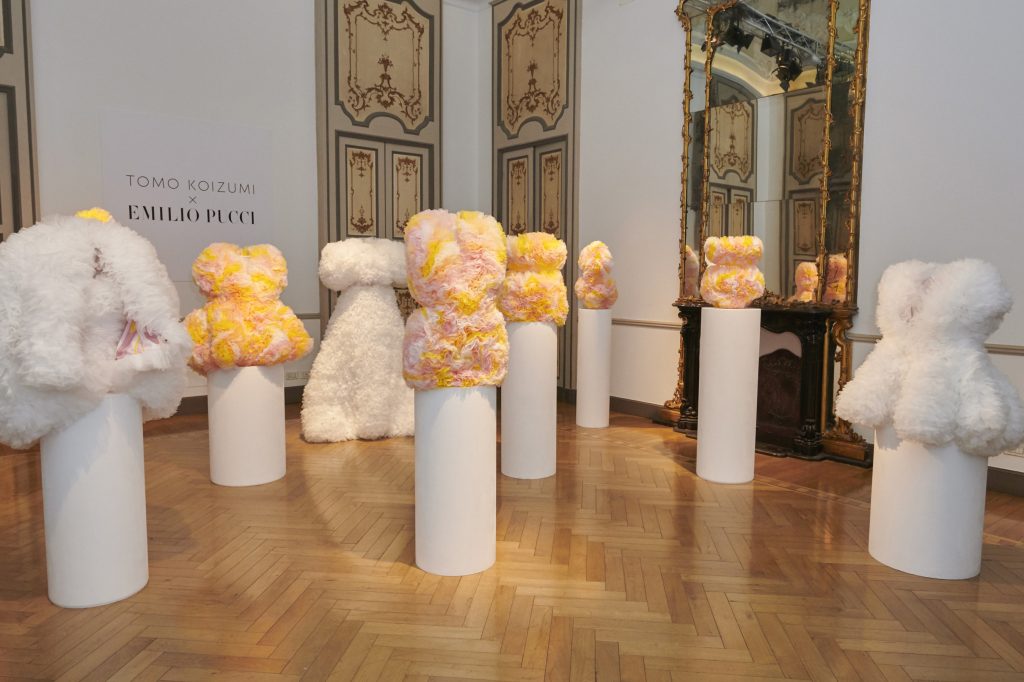
Koizumi and Pucci should have insisted that commerce and art – outside in the courtyard and inside the mansion displayed as sculptures rather than real dresses – be in a dialogue rather than talking at each other.
Having the talent of this Japanese designer create a series dresses using of Pucci’s heritage print like the ‘piazzetta di capri’, ‘la canzone del mare’ and ‘conciglie’ is a marvel, but getting Koizumi to distill his design sensibility and his aesthetics to the rest of the Emilio Pucci collection would have been surely a greater endeavor.
For sure, the wonderful costume garments will grab the attention of the arty fashion fans but how and if they will be translated in clothes that can be sold and worn is another unknown. Or does this question even matter anymore? It is also about the potential of the Pucci brand giving Koizumi an opportunity to demonstrate his apt as a fashion designer to make clothes for women to wear not only for women to parade around to be stared at or to be observed.
PORTS 1961
Sfilate
Ports 1961 inaugurated the brand’s new creative, in place since the fall of 2019, with an inaugural show in London that spring season with the mission to reimagine the brand and the products under the stylist Karl Templer and the art director Fabien Baron and based out of London.
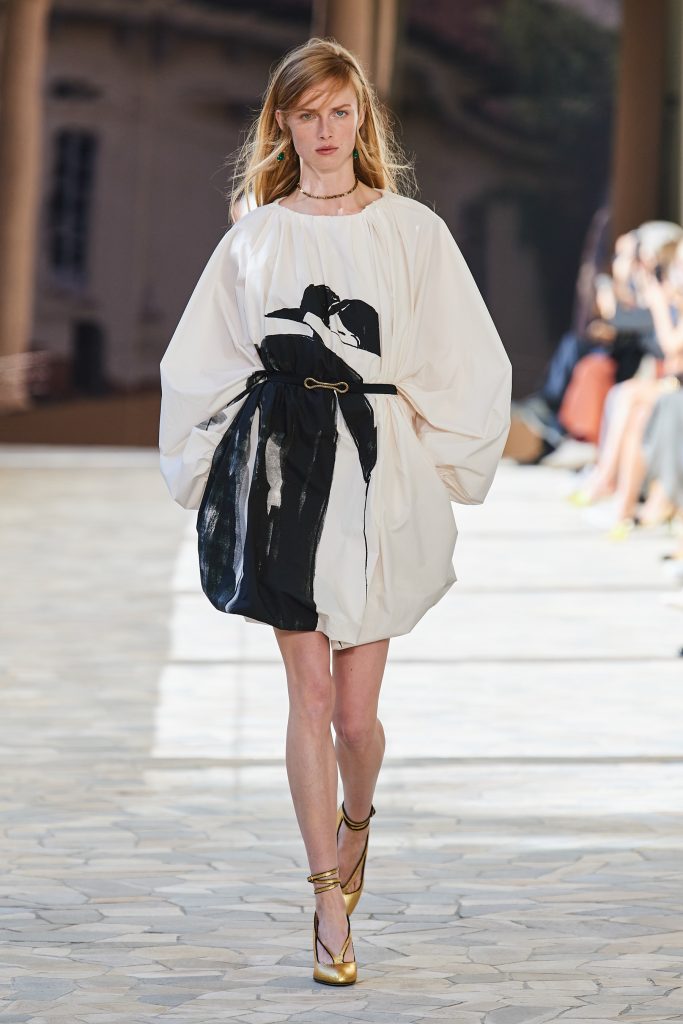
The collection Templer sent out on models in Milano showed his characteristic silent elegance with individual touches that make each garment personal to the wearer. The opening look of a white oversize short dress with a black and white print at the front and tied with a black leather belt at the waist spoke to the ease the pervades the entire show mostly dresses, coats, and two slouchy pantsuits in mostly white and black with solid red and marigold here and there. Among the highlights of the show was a long-sleeve tan loose fitted dress with tan leather belt, an asymmetrical pleats ecru long dress, and a simple black dress with perforated floral patterns.
The clothes don’t scream fashion and perhaps that was the intention.

